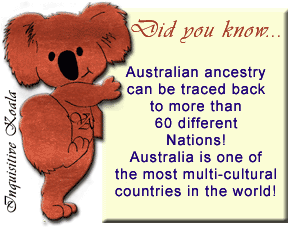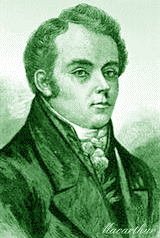






 |
AUSTRALIA
~
British Settlement ~
Captain Cook's account of his
discovery aroused much interest in England but Britain did not try
to colonise Australia until its American colonies achieved
independence. On 13 May 1787, the
first fleet of 11 ships sailed from England under the command
of Capt. Arthur Phillip. They reached Botany Bay on 18 January
1788 with 1530 people, 736 of them convicts. Finding the bay a
poor choice, the fleet left eight days later to establish a
settlement at Port Jackson, a few kilometres north. Here, Phillip
began the first permanent settlement on January 26, now known as
Australia
Day. The settlement grew to be Sydney, Australia's biggest
city with one of the world's best natural harbours. It was named
Sydney for Britain's home secretary, Lord Sydney, (1733-1800), who
was responsible for the colony. Phillip's domain covered half of
Australia (from the eastern oceanic waters to as far west as the
135th meridian), but his human resources were limited.
Three major problems confronted the
early governors: providing a sufficient supply of foodstuffs;
developing an internal economic system; and producing exports to
pay for the colony's imports from Britain. Land around Sydney was
too sandy for suitable farming, and the colony faced perpetual
food shortages through the 1790s. (Natural food sources were
largely limited to fish and kangaroo.) Phillip established farms
on the more fertile banks of the Hawkesbury River, a few miles
north-west of Sydney, but this land was often flooded or still
used by the Aborigines. Food supplies came mainly from Norfolk
Island, nearly 1,600 km (about 1,000 miles) away, which Phillip
had occupied in February 1788; the island later served as a jail.
In 1792 the Royal Marines were
replaced with the New South Wales Corps, which had been
specifically recruited in Great Britain. Given grants of land,
members of the corps became the colony's best and largest farmers,
but they also posed a serious threat to the governors by their
power over the economy. With a sharp eye for enhancing their
income, they specialised in controlling the price of rum, which
served largely as the colony's internal means of exchange.
Phillip's successor as governor,
Capt. John Hunter (1738-1821), who arrived in 1795, tried in vain
to gain control of the rum traffic. The next governor, Capt.
Philip G. King (1758-1808), who served from 1800 to 1806, was no
more successful.

The island settlement at Hobart in
Van Diemen's Land (now Tasmania) was established in 1803 to
accommodate convicts and to quash any possible French claims to
the island.
In 1806 Capt.
William Bligh replaced King. Bligh had gained notoriety
earlier, when the crew of his ship, the Bounty , had mutinied in
the Pacific. Bligh threatened the corps with the loss of their
monopoly. He was met with the so-called Rum Rebellion, and on Jan.
26, 1808, Lieutenant
Colonel George Johnston (a relative of mine) arrested him.
Bligh was later sent to London,
where he successfully defended his policies, but he was not
restored to his governorship. The Rum Rebellion thus gave the
leaders of the corps immediate victory.
 Meanwhile,
one of its ringleaders, John
Macarthur (1767-1834), had found the solution to the colony's
lack of valuable exports; in 1802 he had shown British
manufacturers samples of Australian wool. It was only after 1810,
however, with the breeding of the merino sheep, with its long
staple wool, that sheep grazing gradually developed into a major
economic activity. Meanwhile,
one of its ringleaders, John
Macarthur (1767-1834), had found the solution to the colony's
lack of valuable exports; in 1802 he had shown British
manufacturers samples of Australian wool. It was only after 1810,
however, with the breeding of the merino sheep, with its long
staple wool, that sheep grazing gradually developed into a major
economic activity.
Bligh's replacement,
Lachlan
Macquarie (1762-1824), served as governor from 1809 to 1821.
The New South Wales Corps was sent home, and because the economy
had improved, the government gained stability. Macquarie began an
extensive public works program, employing the ex-convict
Francis
Greenway (1777-1837) to design churches, hospitals, and
government buildings in Sydney. The population of the colony also
increased after Britain's defeat of Napoleon in 1814.
The arrival of more free settlers
brought increased claims to farmland on which more convicts could
serve as labourers. These two groups of colonists, however,
reflected a growing tension within New South Wales. As convicts
completed their sentences or were eligible for release due to good
behaviour, they sought land and opportunities. They were known as
the emancipists, and their leaders urged that they be given more
rights. The free settlers, like the corps before them, maintained
that convicts, even after their release, should not be treated as
equals. These opponents to the emancipists were known as the
exclusives. Macquarie, as had Bligh, tended to support the
emancipists, granting them land and appointing them to minor
offices. The exclusives became critical of both Macquarie and the
emancipists.
Macquarie's government was
expensive, and most of the burden had to be carried by the British
treasury. Overseas punishment, however, did not appear to have
reduced the number of convicts, and many wondered if New South
Wales was the proper solution to Britain's crime problems. In
1819, the British Colonial Office sent Judge John Thomas Bigge
(1780-1843) to inspect and report on Macquarie's administration.
He recognised the colony's growing importance to the British
Empire as a home for wealthy free settlers, and he popularised the
name Australia for the southern continent. Bigge's reports
resulted in a major change in the constitution for New South Wales
in 1823.
New South Wales was granted the
first constitutional charter by a British law, authorising the
creation of a Legislative Council with limited power. In 1825, by
an executive order of the British government, the island
settlement of Van Diemen's Land (present-day Tasmania) became a
separate colony.
Copyright
unknown

History
Index

|







 |